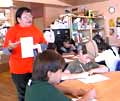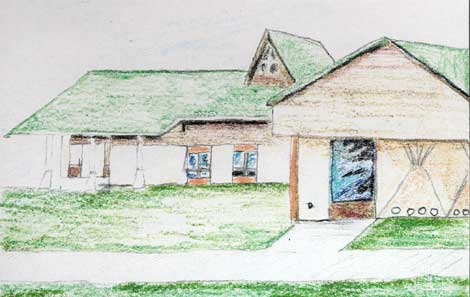Piegan Institute and Language School
http://www.pieganinstitute.org
The Mission of the Piegan Institute, founded in 1987, is to serve as a
vehicle to research, promote, and preserve native languages. The Nizipuhwahsin
(original language) Center of the Piegan Institute is located on the Blackfeet
Reservation in northern Montana and teaches the native Blackfeet language.
Their objective is to generate highly skilled speakers who are educated
in both Blackfeet and world academia. While the programs teach the language,
they include social, intellectual, and academic lessons. They focus on
connecting the various contexts of the students' experiences.
The decline in usage of native languages resulted from forced attendance
at English-speaking schools where speaking native languages was forbidden.
Because most adults experienced this type of education, less than 3% of
Blackfeet are fluent in their own language, and most of these people are
elderly. The Piegan Institute wants to increase the number of Blackfeet
speakers, especially children, and to assist with positive community development.
As a native language school, the Institute supports native languages of
all tribes through education and hopes to provide a voice to the national
and international restoration of native languages.
The Nizipuhwahsin Center is a school that operates on
contributions from nixokowa, friends and relatives, only.
It receives no
operating funds from federal, state, or tribal governments.
In addition to individual support, it has a few private foundations
that have invested in saving the Blackfeet language.
At the school, children learn from elders and state certified
teachers who speak the Blackfeet language together. They
have 40 students enrolled from ages 5 to 12 in the multi-age
classrooms.
The multi-generational approach involves the children, their
parents, and grandparents in the learning process.
Blackfeet Community College - Blackfeet Language
Studies Department
www.bfcc.org/
Students can study the Blackfeet language at an elementary conversational
level or they may engage in a more intensive study. Beginning students
focus on a different topic each week including such themes as greeting
others, distinguishing kinship, identifying community geographic sites,
and pronouncing names of legend figures and Blackfeet spirit entities.
Instructors use role play situations, photographs and other illustrations
to assist the immersion learning experience.
For the more intensive beginning course, students are immersed in the
culture of the Blackfeet. Prayer and words used in and around ceremonial
gatherings are taught, word origins are taught, and Blackfeet philosophy
is stressed throughout the course by emphasizing the choice of words.
Elders play an important part of the classroom presentations.
Intermediate Blackfeet language classes present conversational topics
that are both relevant and usable in daily interactions with the average
Blackfeet speaker.
Topics include temperature and weather systems, plant life, methods of
describing feelings and the various community activities prevalent in
the Blackfeet community. Blackfeet language lessons are also available
in video or audio and written materials.
Blackfoot Language
http://www.native-languages.org/blackfoot.htm
This site gives a brief description of the language,
people and history of the five affiliated Blackfoot
tribes, including Siksika, Peigan, Pikanii, Kainai,
and Blackfeet. It includes a vast resource of Blackfoot
language links as well.
|






